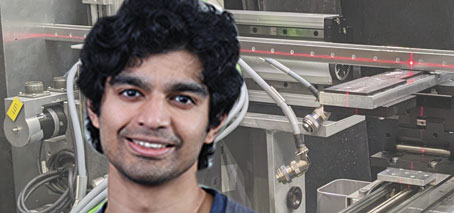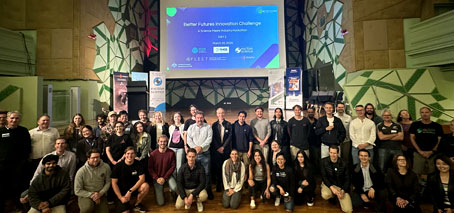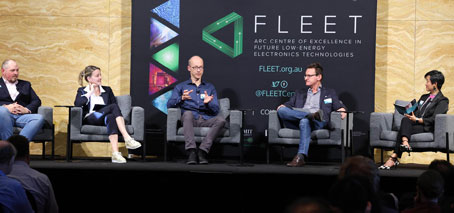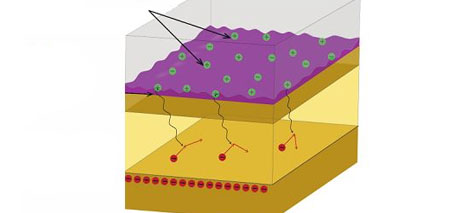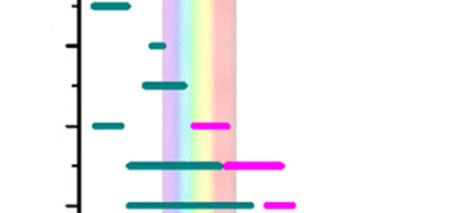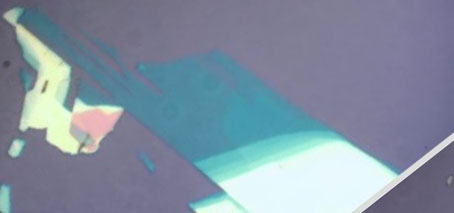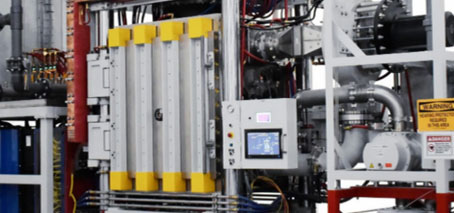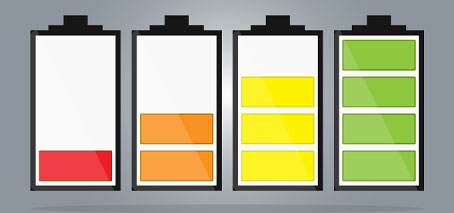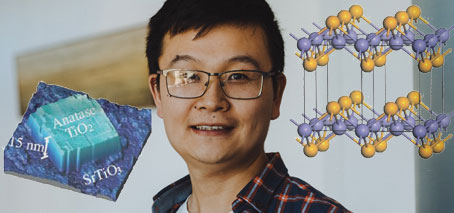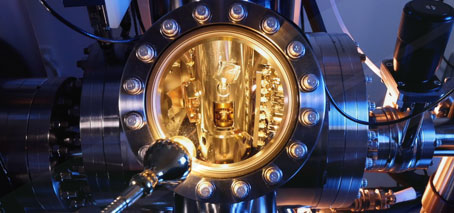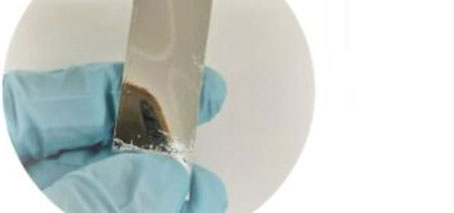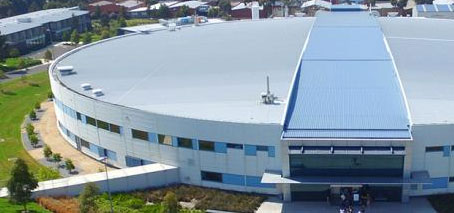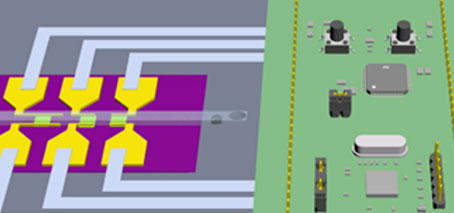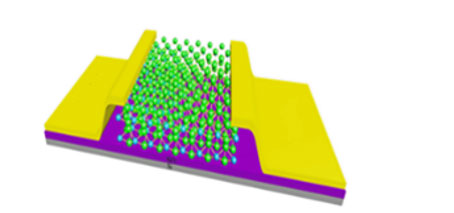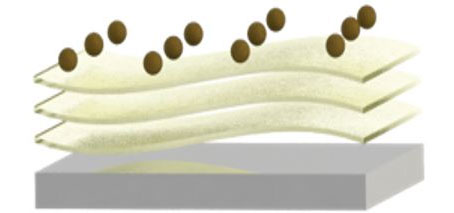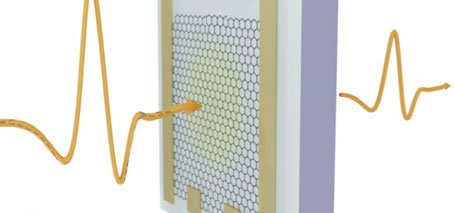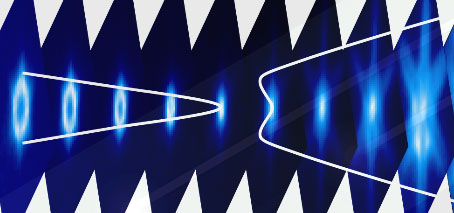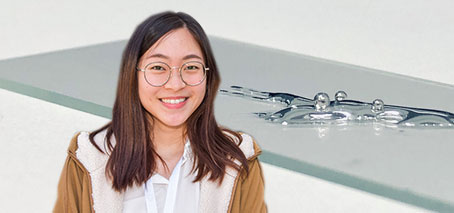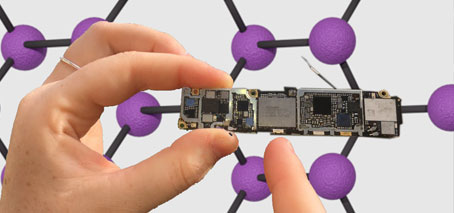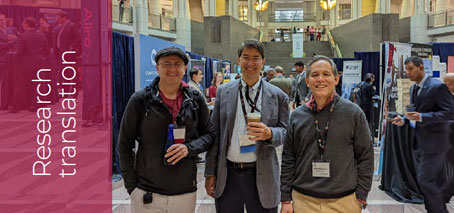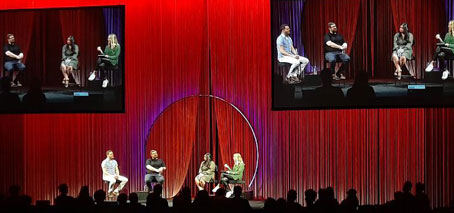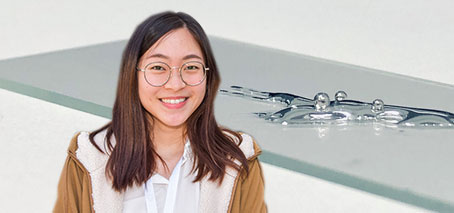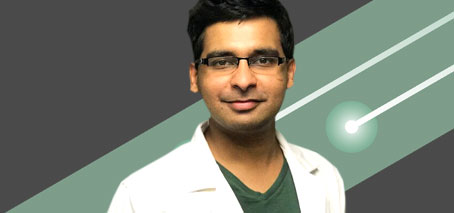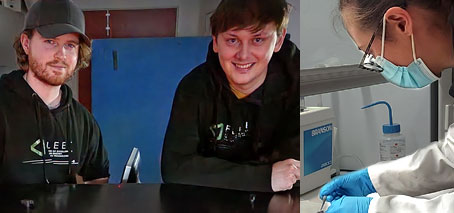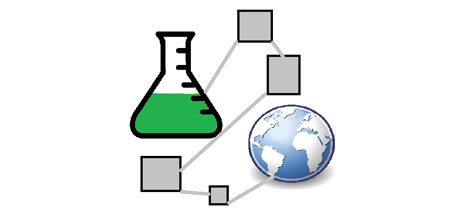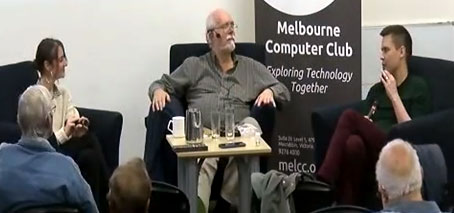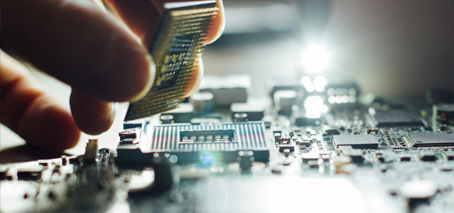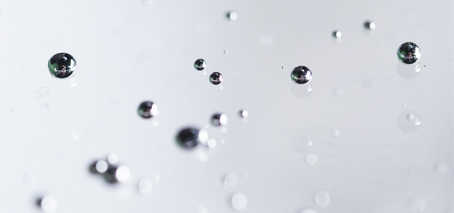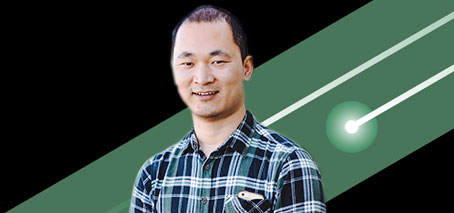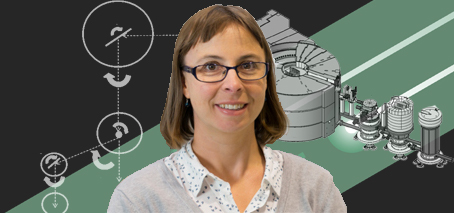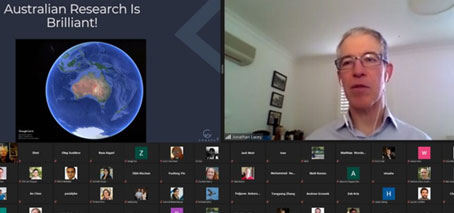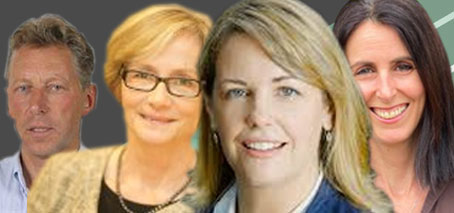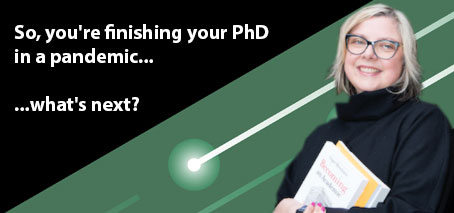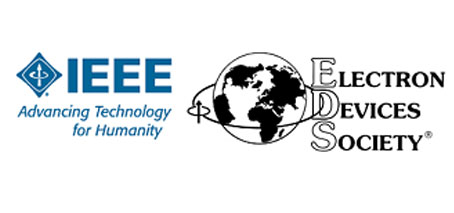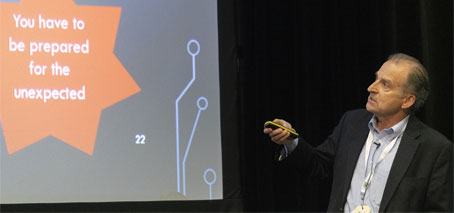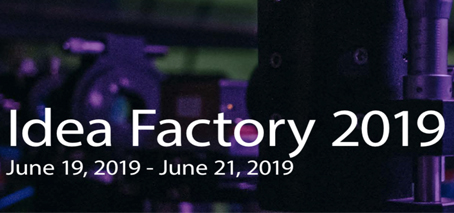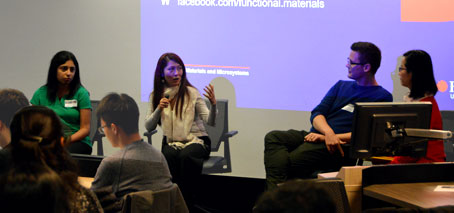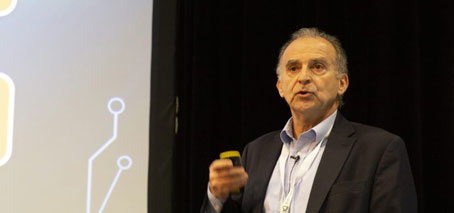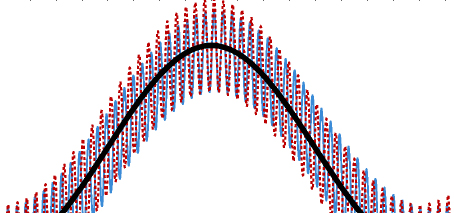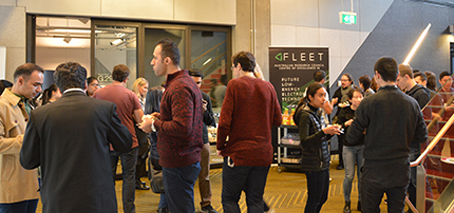Sangeet Kumar was the inaugural intern for the FLEET internship program, working at ANSTO, performing neutron reflectrometry experiment to study ion-beam modified 2D materials. Sangeet reports back on whart he learned: “I recently finished my two-month FLEET ANSTO internship at Lucas Heights, NSW. I’m grateful for the financial support provided by FLEET as an additional stipend, and for ANSTO’s support …
Better Futures Industry Challenge 2024
Faster ways to respond to emergencies and ultra-sensitive quantum seismometers for earlier detection of earthquakes, were two ideas that emerged from teams of intrepid researchers from five Centres of Excellence who competed in the inaugural Better Futures Innovation Challenge to solve critical industry problems. Industry partners for the deep-tech hackathon had access to researcher skills spanning the fields of physics, …
Meet FLEET innovation-and-industry event
An audience of around 90 gathered for the Meet FLEET event at UNSW earlier this month, comprising researchers, industry representatives and others. A major aim of the event was to serve as a bridge, fostering connections while providing industry professionals and researchers the opportunity to delve into collaborative research and development programs. Meet FLEET also showcased the Centre’s research capabilities …
Beyond imaging: neutron reflectometry of semiconductors and quantum materials
A Meet FLEET innovation-and-industry event poster The Challenge How can one “see through” the layers of a dilution refrigerator to study the magnetic flux in a thin film or superconductor at cryogenic temperatures? How can one study and control the high-temperature annealing of nanoscale film heterostructures at 1600 K in a vacuum furnace? The ability to “see inside” components is …
New technology for ultra-low noise quantum devices
A Meet FLEET innovation-and-industry event poster The Challenge Increasingly smaller structures in nanoelectronic devices are desirable from an industry standpoint. Smaller devices lead to increased operation speed, packing density and lower power usage. There is a problem however with making smaller devices; the electrons need to be closer to the surface, and this worsens the electric properties of the device …
Two-dimensional natural hyperbolic materials
A Meet FLEET innovation-and-industry event poster The Challenge Metamaterials are synthetic materials whose electromagnetic properties are determined not by their constituent atoms or molecules, but rather by the specific arrangement of these components, leveraging the assembly of subwavelength meta-atoms. They present several challenges including fabrication complexity, bandwidth limitations, issues with loss and absorption, scalability concerns, the pursuit of multi-functionality, sensitivity …
Manufacturing advanced quantum materials: Monolayer semiconducting TMDCs
A Meet FLEET innovation-and-industry event poster The Challenge Monolayer TMDCs are a unique class of 2D semiconductors, which exhibit properties ideal for future quantum technologies. However, their manufacture and characterisation is time consuming and requires extensive experience. Additional complexity is introduced by stacking monolayers with a high degree of precision. The angle dependence provides tunability of the optical and electrical …
Solving for the effective properties of electromagnetic composites
A Meet FLEET innovation-and-industry event poster The Challenge Metamaterials = artificial structures with properties that do not occur in nature. They are used to make electromagnetic absorbers and communication devices at microwave, infrared and optical frequencies. A way to accurately predict electromagnetic properties of metamaterials is needed. Predicting metamaterials’ effective or average permeability has been a challenge for over a …
High-bandwidth vector magnetometry for communication and navigation
A Meet FLEET innovation-and-industry event poster The Challenge Navigation and communication in challenging environments (e.g. underground/underwater) requires new technology to offer capability comparable to above-ground options. Such capability would allow for underground mine automation, submarine communication and drone navigation. Investigation into new magnetometer technology requires application of precision bias fields, often with other requirements such as optics, microwaves, etc. Making …
High-performing n-type thermoelectrics based on bulk porous topological insulators
A Meet FLEET innovation-and-industry event poster The Challenge Most of the power used in society is lost to the environment in the form of waste heat. Thermoelectric (TE) modules can convert waste heat gradients into useful electricity via the Seebeck effect. When run in reverse, such modules can also provide active cooling via the Peltier effect. Bi2Te3 is currently the …
Safe, affordable and durable Zinc-ion batteries
A Meet FLEET innovation-and-industry event poster The Challenge The development and deployment of energy-storage technologies are critical to meet the demands of the stationary global market, which is growing at 24% per year. While lithium-ion battery technology may appear suited, its high cost, unavoidable safety concerns, resource strains and extreme demand/supply imbalance are massive deterrents for mass adoption. We need …
High-temperature superconducting electronics
A Meet FLEET innovation-and-industry event poster The Challenge Superconducting electronic devices indeed have a broad range of applications, including single photon detectors, Josephson Junction Devices, High-Frequency and RF Electronics, and Superconducting Quantum Bits. However, a notable challenge in the field of superconducting electronic devices is that conventional metal superconductors can only operate at extremely low temperatures, typically only a few …
Scanbot: An STM Automation Bot
A Meet FLEET innovation-and-industry event poster The Challenge Scanning Tunnelling Microscopes (STMs) are capable of acquiring images of surfaces with atomic-scale resolution. They accomplish this by scanning an atomically sharp probe across the surface of a sample while monitoring an electric current. Conditioning (e.g. sharpening) of the probe, along with finding regions of interest on a sample are two time-consuming …
Supercapacitors: The future of energy storage
A Meet FLEET innovation-and-industry event poster The Challenge Thin-film supercapacitors offer a solution to the limited energy storage capacity of traditional batteries in portable electronics. They provide rapid energy discharge and recharge capabilities, which is critical for devices like smartphones and wearables. The compact nature of thin-film supercapacitors and their flexibility makes them suitable for miniaturized devices, including medical implants, …
The Australian Synchrotron: A materials analysis toolkit
A Meet FLEET innovation-and-industry event poster The Challenge Development of advanced quantum technologies and devices requires a fundamental understanding of the constituent building block ‘quantum materials’ which underpin their exciting properties Quantum materials require high purity and order (structure and chemistry) Precision measurement techniques are required following growth/fabrication. The Solution The Australian Synchrotron is the southern hemisphere’s brightest source of …
Automated sensors for stand-off detection of toxic gases
A Meet FLEET innovation-and-industry event poster The Challenge Capability for fast, automated, stand-off detection of toxic gases at the parts per million (ppm) level is required for environmental monitoring, early detection of bush fires, toxic emissions from metal processing or mining. This capability can be used for monitoring the spread of toxic gases and aid in the decision-making capabilities in …
Biosensors for point of care testing
A Meet FLEET innovation-and-industry event poster The Challenge Using current technologies, screening of lethal diseases such as cancer is painful (uses body tissue), time consuming and requires infrastructure only accessible to specialist trained personnel at big hospitals or testing facilities. Easy-to-operate, low-cost and fast-sensing of disease markers, directly in human blood, will enable extension of medical screening and monitoring facilities …
Wearable EEG sensor with Epitaxial Graphene
The Challenge Deploying a high-efficiency, non-invasive Brain Computer Interface (BCI) system for hands free control of electronic devices, cognitive monitoring or entertainment applications. Most non-invasive BCI systems use electroencephalograph (EEG) nodes to read out bio-potentials from the scalp. Commercially-available dry EEG electrodes are often made of metals or conductive fabric and typically suffer from high impedance and low signal-to-noise ratio, …
Visible switching coatings for Smart Windows
A Meet FLEET innovation-and-industry event poster The Challenge As urban centres around the world grapple with the dual challenge of rising energy demands and the urgent need to reduce carbon emissions, the integration of smart infrastructure becomes pivotal. A significant amount of a city’s energy is consumed by building heating, cooling, and lighting. Innovations like tint-adjusting windows, heat mirrors, and …
Topological thermoelectric films with controlled porosity
A Meet FLEET innovation-and-industry event poster The Challenge There is a high demand for flexible thermoelectric films that can be incorporated into low-energy electronics to recapture waste heat and enable wearable battery-free devices. High performance thermoelectric materials require high electrical conductivity generally being accompanied by low thermal conductivity. However, these two quantities are typically linked with high electrical conductivity resulting …
Terahertz frequency switching in graphene
A Meet FLEET innovation-and-industry event poster The Challenge The International Energy Agency (IEA) has identified computing, and in particular data centres, as a rising source of energy usage. Energy generation continues to be dominated by the burning of fossil fuels such as gas, coal and oil – all of which produce carbon dioxide (CO2 ), which contributes to the Greenhouse …
Towards high-temperature lossless electronics
A Meet FLEET innovation-and-industry event poster The Challenge Scientists are continually searching for ways to increase computing power while reducing power consumption. A big step forward would be finding materials that conduct electrons with near-zero resistance at high-temperature and with all their spins aligned in one direction. The Solution Our solution is a layered “sandwich” structure comprising of a thin …
Aluminium oxides-based LED encapsulant
A Meet FLEET innovation-and-industry event poster The Challenge Light-emitting diodes (LEDs) are consumer electronics that play a crucial role in our daily life-from a mobile phone to LED billboards, LEDs are ubiquitous. There are, however, delicate components sitting inside each LED unit that need to be protected in a dry and oxygen free environment. The lifespan of typical LEDs is …
New funding to spark collaboration between industry and FLEET students
An exciting partnership between FLEET and APR-intern will fund new route to gain valuable ‘on the floor’ industry experience for FLEET PhD/Masters students, increasing job skills and leveraging Australian scientific expertise in industry, with funding supporting the placement of research students with industry partners. In addition to injecting fresh scientific and problem-solving energy into participating industry workplaces, the program will …
Next-generation low-energy transistors
A Meet FLEET innovation-and-industry event poster The Challenge Energy usage for computing has been recognized by the Breakthrough Energy Fund as one of the world’s major problems needing future solutions. Carbon dioxide (CO2) emissions are linked to climate change. While energy production and chemical industries are the major CO2 producers, large data centres and computing technology, in general, are also …
Research translation in 2022
Translating FLEET research to industry innovations with societal impact With a goal to help transform Australia’s electronic technologies and work towards research translation outcomes, FLEET is actively building partnerships and links with research and industry organisations working on novel electronic devices and systems. ENGAGING WITH INDUSTRY Progress towards this important goal in 2022 included: Initiating the FLEET Translation Program (see …
Turning up the heat on topological thermoelectrics: FLEET Translation funding towards new chemical synthesis
FLEET funding is supporting the next step in possible translation of thermoelectrics research towards commercialisation in future generators, electronics, vehicles, human-wearable and environmental sensors, and smart electronics Thermoelectric materials offer potential solutions to heat-management challenges common to many electronics technologies. Thermoelectrics are solid-state semiconductors that can convert heat gradients into useful electricity (known as the Seebeck effect). They can also …
Learning to see yourself in an entrepreneur role: Sunrise Innovation Festival
FLEET PhD candidate Maedehsadat Mousavi’s has reported in following attending the Sunrise innovation festival, building on her experiences at the EQUS-FLEET Idea Factory: “Previously, I would have never considered starting my own company or launching a start-up, but now I can see myself considering this future, and how an entrepreneur can have an impact on the world.” FLEET HDR students …
Zinc batteries, cheaper safer better: FLEET Translation Program
FLEET Translation funding is progressing zinc-ion battery technology, which offers decreased costs, safety, and improved environmental outcomes. Current commercial batteries are primarily based on lithium-ion technology, which is expensive and has significant safety concerns owing to incorporation of flammable organic materials. The proposed aqueous zinc-ion battery technology boasts improved safety (no toxic or flammable components), low-cost manufacturing, and recyclability. The …
FLEET translation: extending LED device lifetime with liquid-metal printed oxides
2D oxide-based LED encapsulation extending device lifetime FLEET translation funding is supporting the next step in a liquid-metal printing application with significant commercial promise, in a project being led by RMIT PhD candidate Patjaree Aukarasereenont. Light-emitting diodes (LEDs) play a crucial role in modern society – from mobile phones to LED billboards and home lighting, LEDs are ubiquitous. There are, …
Critical Technologies submission
FLEET has made the following submission towards a review of Australia’s ‘critical technologies’, ie current and emerging technologies critical for Australia today (or could become critical within the next 10 years), aimed at giving Australia a clear competitive advantage, accelerating productivity growth, and creating well-paying jobs. The ARC Centre of Excellence in Future Low-Energy Electronics Technologies (FLEET; FLEET.org.au) is a collaboration between …
Automation takes the misery out of scanning microscopy: FLEET Translation Program
FLEET Translation Program funding to automate the ‘boring parts’ of STM experiments, freeing up operators’ time Monash PhD candidate Julian Ceddia has been awarded funding from the first round of the FLEET Translation Program to further develop the automation of Scanning Tunnelling Microscopes (STMs), based on previous work from the group of his supervisor, Agustin Schiffrin. STMs are capable of …
New FLEET Industry Relations Chair
FLEET is very pleased to report that Centre AI, Sumeet Walia at RMIT has been nominated by the FLEET Executive Committee to chair our Industry Relations Committee from Aug 2022, and has agreed to take on the position. The Centre Exec and Ops Team would like to thank Torben Daeneke for his leadership in the past two years as Chair …
What you see is what you get with pre-characterised TMDs: FLEET Translation Program
First project approved for FLEET Translation Program funding PhD candidates Mitch Conway, Abby Goff, and Jack Muir have recently been awarded $31,000 in FLEET’s first round of funding from the FLEET Translation Program (FTP). Their cross-node collaboration between Swinburne and RMIT aims to create a catalogue of high quality 2D materials, namely transition metal dichalcogenides (TMDs) and their heterostructures. …
Translating research discoveries: introducing FTP
“Inventions and new products come from combining novel and existing technologies” (Joseph Schumpter) What is ‘translation’ anyway? And what are the benefits for me / my work? Does this apply to my work? Will industry be interested in what I’m doing? (Spoiler: Yes it does! Matt Davis explains quantum weighbridges) How can FLEET help me do this? A FLEET audience …
Engaging with end-users: Meeting the Melbourne Computer Club
What is the future of computing? As Moore’s law is approaching an end, new technologies are required to enable further advances in computational speed and energy-efficient data processing. As transistors took their first baby-steps over half a century ago, the next generation of electronic switches are being born today. Engaging with the Melbourne computing and electronics community in a ‘fireside …
Engaging with industry in 2020
FLEET is building links with partners interested in novel electronic devices and systems working towards the overarching goal of creating pathways to translations of research outcomes. Progress towards this important goal in 2020 included: Adding topological transistors to the Institute of Electrical and Electronics Engineers (IEEE) International Roadmap for Devices and Systems Lodging two provisional patents: topological switching (Fuhrer Monash and …
Topological-switching patents demonstrate FLEET’s dominance in field
Two patent applications, one filed in 2020, reinforce FLEET’s position as a world leader in topological transistors. The patents cover work in the ‘switching’ of topological material, to facilitate creation of a functioning topological transistor – a proposed new generation of ultra-low energy electronic devices. Their world-first success was the switching of a material via application of an electric-field between …
Liquid metals spin-off launched
The Liquid-metals spin-off company Liquid Metal Plus (LM+) initiated in 2020 with FLEET investigators Kourosh Kalantar-Zadeh (UNSW) and Dr Torben Daeneke (RMIT), together with Dorna Esrafilzadeh (UNSW), was launched in April 2021. Pushing print on flexible touchscreens Climate rewind: turning CO2 back into coal The company has two areas of focus, with the unifying theme being application of liquid-metal technologies …
Explainer: Linkage funding for topological-thermoelectricity
A team led by FLEET CI Prof Xiaolin Wang (University of Wollongong) has won a linkage project for topological materials based thermoelectricity. Thermoelectricity can directly convert heat to electrical energy or vice-versa. It plays an important role in renewable and sustainable energy by harvesting waste heat, which is widely available in human body, computer chips, sunlight and steel industry. Thermoelectric …
Thermoelectric devices convert waste heat from industry into viable new energy source
New research supports development of thermoelectric devices to convert waste heat from industry into a viable new energy source Australian industries could benefit from being able to harness the heat by-products from operations Development of advanced materials can sustainably convert waste heat into useful forms of energy to benefit Australia. The work will be undertaken as part of an Australian …
Building future science leaders in 2020
FLEET ensures that our young researchers are prepared for future success – wherever their career takes them. The Centre currently supports 64 higher degree by research (HDR) students and 45 postdoctoral researchers with another 21 research affiliates working on FLEET projects and invited to Centre training, workshops and events. FLEET connects its researchers with internal and international networks, for example, …
Skilling up our people in 2020: research impact and industry engagement
—Who would be interested in my research? Who would benefit from it the most? —How can I pursue high-impact research? —How does research translation work? —If I’ve developed some cool intellectual property, where would I start with industry engagement? —How do I effectively ‘sell’ the value of my research in an award application/grant/job interview? While researchers are typically familiar with …
Putting FLEET science on the map
Topological transistors added to IEEE International Roadmap for Devices and Systems The remarkable advances in semiconductor technology (guided by the so-called ‘Moore’s Law’ over some six or seven decades) don’t just happen. They are steered through an international, pre-competitive industry roadmap. The IEEE International Roadmap for Devices and Systems ‘IRDS’ is the latest semiconductor roadmap, guiding development of more conventional …
Invited: Research Translation Journeys
About the presenter Jonathan Lacey has been involved with technology commercialization since the late 1980s, as a researcher and inventor, product champion, investor and entrepreneur; at universities, large corporations and start-ups. He had 10 years experience working in Silicon Valley with HP-Broadcom. He joined CSIRO in 2011 to drive commercialization of the NGARA wireless communications technologies, and more recently …
ARC funding for FLEET investigators
Australia’s Minister for Education Dan Tehan announced $280 million in funding for new research collaborations to start next year. This month’s ARC Discovery Project and Linkage Project funding announcement includes eight grants for projects and facilities led by or involving FLEET researchers. While these projects are distinct from FLEET’s mission to build low-energy electronics, they testify to the capacity FLEET …
Adding expertise with new Centre advisors
FLEET has significantly added to the expertise available to guide Centre policy and science, with the latest additions to the FLEET Advisory Committee (FAC) and International Scientific Advisory Committee (ISAC). We welcome to our Centre advisory committees Professor Rebekah Brown (Monash University), Dr Esther Levy (Wiley), Francois Peeters (University of Antwerp) and Joanna Batstone (ex IBM). Prof Rebekah Brown is …
Semiconductor industry links and resources
A collection of links and resources relevant to semiconductor/electronics/CMOS industry Additions/improvements welcome! (Email Errol) The semiconductor value chain : image Semiconductor manufacturing process: image Semiconductors: The Ultimate Bargaining Chip: video – Semiconductors’ role in society, future’s dependency on them. NZS Capital’s Jon Bathgate & Brinton Johns explain major semiconductor players, what’s important, how things work, complications of geopolitics. Global data …
Skilling researchers up for a post-pandemic career
Around 35 PhDs and other Early Career Researchers from FLEET and partner organisation the MacDiarmid Institute took a chance last week to learn how to take control of their future in these uncertain times, and to gain a better understanding of the job market (both in academia and industry) with a targeted, one-hour workshop from “the thesis whisperer”. A/Prof Inger …
What comes after CMOS? An expert discussion
A panel of experts featuring Dr Paolo Gargini (formerly Intel, head of several international semiconductor roadmaps), Prof Michelle Simmons (UNSW, Director. ARC Centre for Quantum Computation and Communication Technology) and Prof Michael Fuhrer (Monash Uni., Director of ARC Centre of Excellence in Future Low Energy Electronics Technologies.) and a guided discussion about the future of electronics beyond CMOS and the role semiconductors and other materials …
FLEET’s engagement with industry in 2019
Working towards the overarching goal of creating pathways to translations of research outcomes, FLEET is building links with partners interested in novel electronic devices and systems. Progress towards this important goal in 2019 includes: Working to include topological transistors in the Institute of Electrical and Electronics Engineers’ (IEEE) International Roadmap for Devices and Systems Lodging two provisional patents Collaborating on …
Building future entrepreneurs: Idea Factory 2019
It’s not easy to convince a group of PhD students and early-career researchers to take three days away from their research to complete a training course. Yet this type of training can provide incredibly valuable skills for these researchers in their future careers and endeavours. At Idea Factory 2019, a joint project with FLEET and the ARC Centre of Excellence …
YouRforum 2019: Got PhD, what next?
Jobs in many of the fastest-growing industries require science, technology, engineering and mathematics (STEM) skilled professionals. The Young Researchers Forum, aka YouRforum was created by FLEET COO Dr Tich-Lam Nguyen (then at the Monash Centre for Atomically Thin Materials) to provide opportunities for young STEM researchers to network, discuss research ideas and practice their professional skills. The program‘s ‘Got PhD, …
Materials Research in the Electronics Industry
The electronics industry has led the development of new materials to support the scaling of silicon device technology to meet the ever-demanding Moore’s law [i] over the last 70 years. Silicon dioxide is a prime example of such scaling from a thickness of several hundred nanometers to about 2 nm at the end of the 1990’s. At that time nitrogen …
Pitch perfect: 2018 Idea Factory
In 2018, FLEET began an ongoing partnership with the ARC Centre for Engineered Quantum Systems (EQUS) to run a yearly ECR workshop building skills in communication, methods for pitching and presenting science, and working collaboratively with others. In between the teams’ pitch preparation and delivery, formal training sessions included science communication, oral presentations and how to craft an engaging research …
Interactions within quantum batteries are key to their charge advantage
Recent theoretical studies at Monash University bring us a step closer to realistic ‘quantum batteries’. Such technology would depend on the energy difference offered by different quantum states, rather than on electrochemical changes, as is the case in traditional batteries. Quantum batteries also offer potential for vastly better thermodynamic efficiency, and ultra-fast charging time. The study, which was co-led by …
Got a PhD? What’s next?
Where can your PhD take you? And how can you maximise your potential future? A group of STEM PhDs and higher degree researchers heard about career options post-PhD at a forum last month, run by FLEET at Monash University. The assembled panel of academics, entrepreneurs, business development and research managers shared their own diverse career journeys and top tips on …

